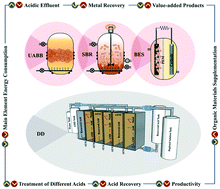Technoproductive evaluation of the energyless microbial-integrated diffusion dialysis technique for acid mine drainage valorization
Abstract
Acid mine drainage (AMD) presents severe ecological pollution challenges because of its extreme acidity and sulphate and toxic metal contents. The bacterial separation of metals by sulphate reducing bacteria (SRB) and diffusion dialysis (DD) are considered as the most efficient techniques for the treatment/valorisation of AMD owing to their low energy consumption and waste effluents. However, the performance of SRB or DD standalone technologies still face several challenges. The integration strategy of these techniques can lead to an improved treatment/valorisation process, with the AMD components recovered and converted into value-added marketable products. These products can financially reduce the total costs of the AMD treatment. In the current review, both approaches, representing the biotic and abiotic methods, are compared in terms of their mechanisms, challenges and efficiencies. In addition, critical evaluations of the feasibility of both methods along with the potential of their integrated processes are discussed and future strategies proposed.



 Please wait while we load your content...
Please wait while we load your content...